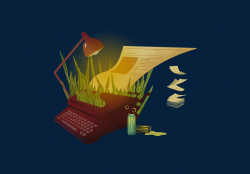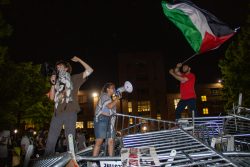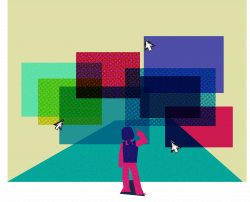To understand the diversity of slam poetry, you only need to look at the hats in the audience. It’s Friday night in ICC Auditorium and slam poet Shihan is hitting the stage in half an hour. In the fourth row, two students are chatting it up. The one with a beard is wearing an olive green, Fidel Castro-type hat, while the baby-faced guy sports a tartan taxi-driver cap. Across the room, there’s a red, droopy flapper bonnet, two white furry J. Lo fedoras and a multi-colored ski cap. The Friday night dinner scene has stolen people away, but there are about 50 enthusiasts here tonight, lured by their love for the spoken word.
Shihan walks in and sits in the back row. A student comes up and tells him that the starting time is being pushed back to wait for more people to arrive. “Yeah, sure, we can wait however long you want,” he says with a casual smile. The Los Angeles-based Shihan has worked as a songwriter for MCA, a writer for Reebok, and recently completed a commercial for Pepsi Blue. He is also the No. 13 ranked poet in the nation.
It may seem odd to rank poets like sports teams, but slam isn’t just art, it’s a competition. In an official poetry slam, there are several standard rules that have been established by the National Poetry Slam Association. A poet must present an original composition, no longer than three minutes and without using any props, music, or costumes. Five audience members are chosen at random to serve as judges and they rate each poem on a scale of one to ten. Unlike purely written poetry, equal emphasis is placed on bodily movement and intonation as on the poem’s content. Normally held in small coffee shops, or other tiny, hip spaces, a poetry slam is usually, and hopefully, a raucous affair.
Tonight, however, is not an official competition. Over the next hour and a half, several students will perform and Shihan will throw down a few pieces, some haiku, and hold court on the following topics: George W. Bush, Iraq, Mayor Giuliani, 9/11, American Idol, Michael Jackson and the present state of hip-hop. Long after he has exhausted speaking about anything he is an expert on, the bulk of the audience stays. It’s a tribute to a comfortable charisma based on his favorite phrase: “That’s fucked up.”
Chidi Asoluka (CAS ‘05) is dressed in a baggy white T-shirt and jeans. He places his battered marble notebook onto the stage and jumps into his first poem, a politically tinged composition on class issues and current events. Asoluka speaks of Burberry pillows and tells George W. to clone himself and go “fight his own damn war.” Audience members in the front rows lift up their hands and snap their fingers in approval.
His second piece is a love poem with the recurring phrase “is that cool with you?” The way Asoluka says it, though, is full of the trepidation of uncertain romance—”Is that … cool … with you?” He stutters, pauses, stops completely and laughs.
Drew Rivera (MSB ‘05) is next on stage. His sleeves are a little too long. Holding up a crumpled white piece of paper with his poem on it, all one can see of his hand are the tips of his fingers. He throws out two love poems and, at one point, begins to scat like Ella Fitzgerald “be bop da bop.” The small spotlight makes his white-gold necklace glimmer. He says, “We had hip-hop elevated to profound.” A murmur of reflection weaves its way through the audience. He walks off.
“I’m not here to perform, oh hell no, I’m making your dendrites grow,” recites Jessica Rucker (SFS ‘05). This is not exactly true. She’s definitely putting on a show. Rucker waves her arms around and moves quickly across the small stage from side to side. At one point, she moves back so suddenly that her head disappears from the circle of illumination provided by the spotlight. Equally as fast, she is again on the middle of the stage. Later asked about her on-stage enthusiasm, Rucker admits, “I know with me, I get very passionate during the performance. Poetry’s a part of literature that evokes emotional awareness.”
Slam poetry has been around since 1986, but only recently arrived at the cultural forefront. It was founded in Chicago by construction worker Marc Smith, who wanted to make verse more accessible to people. From there, it spread to the coasts, New York and California, where it currently maintains a strong presence. Hip-hop mogul Russell Simmons, the patron of slam’s current popularity, produces “Def Poetry Jam” as both an HBO series and a Broadway show. Hosted by Mos Def, the show has featured Erykah Badu, Talib Kweli and Shihan, in addition to various up-and-coming poets. The appearance of these hip-hop artists is appropriate: Slam exists on the border between rap and traditional poetry, mixing the wordplay and emotion of the written form with the power and tempo of song. In slam, however, the beat comes from the rhythm of an individual voice—stressing words here and pausing there, releasing a torrent of alliteration before quieting down to a contemplative whisper.
Still, there is heavy crossover between the two worlds. Chidi Asoluka started writing poetry when he was in the fourth grade and found his way into slam by participating in a high school program. “I think slam poetry is a direct derivative of rap,” Asoluka said. He is wary, though, of rap’s portrayal of African-Americans. “I think what is good about slam poetry is that it gives a voice to something that offsets that point of view, providing an alternative voice.”
“Historically, my people in this country have been silent,” Rucker agreed. “Speaking out against injustices was, for a long time, almost illegal … For me to speak about my personal experiences is very refreshing and rejuvenating.”
But slam isn’t just a black thing. Indeed, one of the most attractive features of the slam scene is its diversity and the top ranked poets in the country span several races, genders and age groups. Shihan’s invitation to perform on campus, organized by GU NAACP and the Georgetown Program Board, was extended in this vein of diversity. GPB President Eric Polkow (CAS ‘04) expressed his organization’s attempts to be more diverse and deflect criticisms of niche marketing to the middle-class, white student.
“I was born with the African drum on my chest,” are the first words Shihan tosses out to the crowd as he curls his hands into claws and lifts up his leg. With the words “puppet” and “ballerina,” his arms go akimbo and he raises high onto one foot, prima-donna style. As the evening proceeds, words fly by so quickly that writing them down would be impossible. Phrases and metaphors are juxtaposed in surprising ways and the poet covers the audience with a blanket of wordplay. Though there is no contest tonight, it’s easy to imagine Shihan using such energy against an opponent.
The competitive nature of slam, where poets are ranked by a point system, arouses criticism from more traditional corners. Canada’s poet laureate, George Bowering, said in an interview with the Vancouver Sun, “To treat poetry as a performance is crude and extremely revolting … People using language in an attempt to get audiences to applaud them on the stage is, well, maybe okay, so long as people do not try to suggest that THAT is poetry.” After making these statements, Bowering was heavily criticized by the slam community. One enthusiast posted on the Internet a picture of Bowering’s head in the crosshairs of a rifle sight. While death threats are hard to endorse, one would be hard pressed to find such ardor amongst devotees of Eliot or Auden.
But the goal of slam is to open poetry to new audiences who normally would not take an interest. Held in the highest regard but read by the least amount of people, present-day poetry exists in a vacuum of inattention. “You say poetry and a lot of people don’t come,” said Shihan. “With the performance aspect, they start to open up their minds.”
The concept of slam runs counter to the classical notion of poetry writing—solitary composition of something that is meant to be read, re-read and studied, not a performative, one-time occurrence. But these critiques overlook the large amounts of rehearsal and revision that goes into a slam poet’s verse. Many people assume that slam poems are composed on the spot. Like any other writing, however, most poets revise their work several times, especially after performing against others. “When you put the competitive aspect into poetry,” Asoluka said, “it makes you want to write better, look for deeper metaphors and deeper images. If you have no one judging your stuff, you can’t tell if you are improving.”
Rucker, similarly, connects the importance of competition to the growth of an artist. “The competitive aspect that [slam] offers adds to my passion for poetry,” said Rucker. “I feel like a lot of stuff I write is meant to be heard, not read.”
The newest exhibition at New York’s Museum of Modern Art, “Matisse/Picasso,” is as good an illusration as any of how rivalry can encourage artistic growth. The show is predicated on the antagonistic friendship of these two giants of twentieth century art and how the process of these painters influencing, mocking and bouncing ideas off each other resulted in greater creative heights. Neither does the slam poet work alone. There is a community and a process that shatters the fable of the lone scribe or the solitary prodigy.
Audience participation is crucial to slam poetry. People in the crowd are encouraged to express their pleasure or dislike of the poet on the stage, through cheering, booing, or other such devices. Attendees at Friday’s show were seen throwing their arms forward in mock dismissal at some of the student poets. One member of the audience scribbled invisible words on his hand and tossed a non-existent piece of paper onto the stage. The audience is the most important piece of the equation. Responses to a performance hold just as much weight as the poet’s work, a philosophy that is as far from the stuffy halls of poetry as one can get.
The success of any slam competition or performance hinges on the relationship between poet and spectator. If a poem lacks any relevance to real-life experience, the writer is going to know. “Slam can be a very call-and-response art, a very functional-type art,” said Rucker. “If people feel that the artist is or is not speaking to their experience, they are going to show it.” More than just a recital of written text, the art form forces the poet to take the audience into consideration, subsequently bringing their words to life.
The dynamism and reciprocal connection of poetry performance is what attracts many to slam, especially young people. “The audience needs to be involved,” Asoluka said. “Slam poetry calls for a more interactive audience. You can’t sit there and be bougie, you have to feel and get into it.
I compare it to church,” Asoluka said, “where the pastor starts speaking and all of a sudden your hands start moving.”
Such uncontrolled enthusiasm can contribute to the flaws of slam. Sometimes poems, especially odes to love, are ridden with cliches. Sometimes there is too much of an emphasis on who can make the audience laugh more. Sometimes the speed of delivery allows the poet to sidestep lyrical flaws—by the time the audience realizes what has been said, he is already a stanza ahead.
Still, most writers are never able to immediately have their work criticized. Audiences can be overly brutal at times, but the competitors themselves appreciate the immediate feedback available from both the crowd and their opponents. Think Eminem in 8 Mile, minus the music, aggression and racial tension.
“A lot of poets have a problem with slam, because they don’t like the performance,” Shihan said. “But, like with an athlete, it makes me work harder at my craft. It tightens up my writing and my performance.”
Shihan is now between poems, mid-show, and he traipses around restlessly on stage. He has just recited a haiku: “You used to be my/sweetest dreams. Now I want you/the fuck outta my head.” The audience erupts in laughter and so does he, a pattern that continues for another 30 minutes.
At night’s end, he jumps down off the stage and stands outside the auditorium, talking to students about almost anything. Rucker and Asoluka linger near the front, watching people file out up the aisles. The two students regard slam poetry as a huge part of their lives, the expression of personal concerns that need to be spoken to be understood rather than stuck in the pages of the Paris Review.
“For me,” Rucker says, “it’s like the minute the words hit the page, the minute the ideas go from my brain to my hand to my pen to paper, that’s the minute I start to be heard.”




